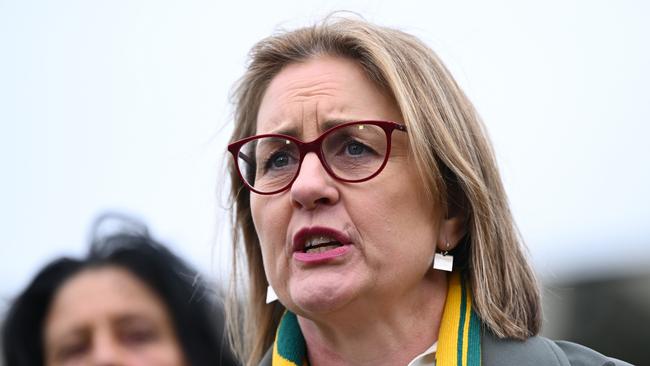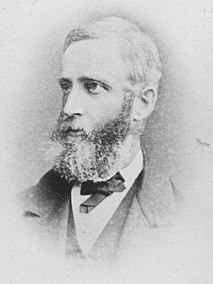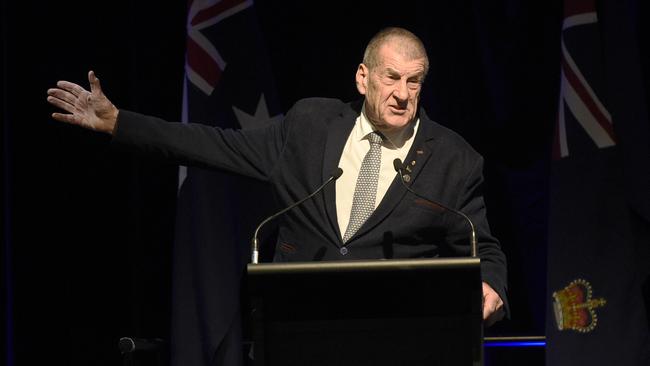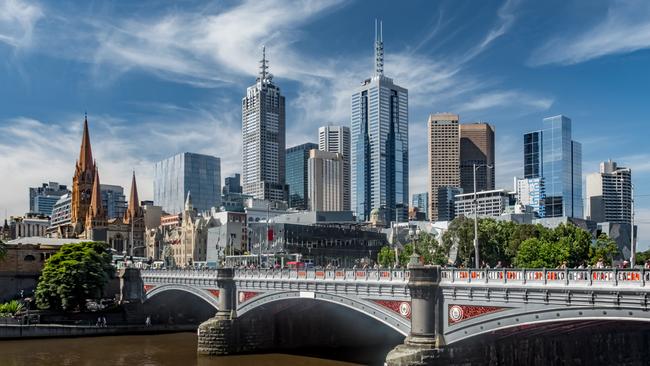What the hell has gone wrong with Victoria?
Victoria’s per capita public debt now stands at $28,000 per man, woman and child – 40 per cent higher than that of the other major states. But the state’s looming fiscal disaster is merely one symptom of a state in much broader disarray.

What has gone wrong with Victoria? Economically, there is no shortage of incriminating statistics. Victorian government spending has more than doubled in the decade since Daniel Andrews took power, increasing at almost twice the economy’s growth rate.
Meanwhile, with revenues falling far below spending, state government debt has grown by an eye-watering 319 per cent, outpacing the economy’s overall growth five times over.
The result is that per capita public debt now stands at $28,000 per man, woman and child – 40 per cent higher than that of the other major states. But measured in terms of per capita disposable income, Victoria is the third poorest state in the country.

That combination of relatively high debt and relatively low disposable income is toxic. And the outlook doesn’t make the picture any prettier.
In effect, productivity in Victoria (how much output its workers and enterprises produce per unit of capital and labour) is rising at less than one-third the rate in NSW. Private capital investment also is lagging badly, limiting the private sector’s long-term capacity to expand.
Together, those factors constrain the rate at which household incomes can rise – and they also mean the taxable base is growing more slowly in Victoria than in the other major states. The state is therefore in a situation where it must fund higher, and still rising, repayments on its debt out of lower, and only slowly growing, incomes.
With investors jittery about the state’s financial viability, interest rates on Victoria’s public debt have been pushed to the point where they are almost one percentage point above the 10-year commonwealth bond rate and are the major states’ highest.
The higher rates have increased debt servicing costs by more than $1bn each year, with the Victorian budget papers predicting that interest payments will more than double from 3.8 per cent of state revenues in 2019-20 to 8.8 per cent in 2027-28.
And those forecasts look unduly rosy: even excluding the two Covid years, the budget has got the fiscal outturn wrong by $5bn a year since 2014-15, with promised surpluses turning out to be lower and deficits higher, adding to debt, interest payments and pressure on rates.
Sure, the government, which shows little sign of cutting spending, could impose further tax hikes, as it already has done on property and much else. But that would merely roil an underperforming economy that only now is recovering from a massive slump in housing starts in 2022 and 2023.
Moreover, Victoria’s taxation levels are already well above the other major states, making additional hikes even more harmful.
In short, the state is, at best, trapped in stagnation, forcing it to cover falling private investment and expenditure with ever greater public largesse. And at worst it faces a Greek scenario: as the spending and debt build-up sets off the alarms, a vicious spiral is triggered in which nervous investors demand even higher rates, increasing debt service costs and worsening the deficit. That blowout then compounds investors’ fears and provokes yet another round of interest rate rises – until the whole Ponzi scheme collapses.
The looming fiscal disaster is merely one symptom of a state in much broader disarray. The extreme violence a month ago at the Melbourne Convention and Exhibition Centre in a city where aggressive street demonstrations and public violence have become a regular occurrence; the slow-moving revelatory apocalypse surrounding John Setka and the CFMEU; the repeated miscarriages of justice (the Pell case, the Gobbo affair, the recently disclosed cover-up by Victorian police in the Andrews 2013 Blairgowrie car crash investigation), the inexorable rise in the number of cases subject to suppression orders and the incessant tensions between the judiciary and the state’s Director of Public Prosecutions – the list goes on and on, all manifestations of underlying rot.
As best one can tell, Labor’s only plan for dealing with the situation is to do more of the same: shoring up voter constituencies through yet more public spending, yet more ill-judged infrastructure projects, yet more giveaways to favoured groups, yet more regulations that empower (and enrich) its friends at the expense of its enemies. The poison is to be cured by administering another dose.
That may sound (and is) pathological. But it is a pathology that has deep Victorian roots. In the 19th century Victoria pioneered a social experiment described – and derided – as “state socialism” that has proved to be one of the most intractable styles of political approach to afflict Australia.
The past decade of first Andrews and now Jacinta Allan’s government suggests the pathology of state socialism was never eradicated but instead has returned to the surface, albeit in modern, debased form.

Victoria’s 19th-century version of liberalism was a sharp departure from – indeed a reversal of – the classical liberalism of William Gladstone, Richard Cobden and John Bright.
In a newly established colony, populated by immigrants who had chosen to journey here for the purpose of realising a better life for themselves and their family, any previous aversion to state intervention quickly dropped away.
The state, in Keith Hancock’s later caustic summary, came to be seen as a vast collective utility, a power to be drawn on in the pursuit of individual happiness.
In the short term that meant governments took on roads and bridges instead of leaving them to toll-financed private operators, built and operated railways, provided universal education, maintained parks and reserves, subsidised charities, outlaid significant funds for artesian bores and rabbit-proof fencing. Public hyper-activism was funded by borrowing: the government accounted for half of all of Victoria’s borrowings from financial markets overseas.
Victoria was certainly not alone in pursuing that strategy. But it took the model to extremes – and did more than any other colony to secure its ascendancy. Particularly important in granting it a polish of intellectual respectability was Charles Pearson (1830-94).

A Cambridge don who transferred from London to Victoria’s parliament in the 1870s, Pearson gave powerful intellectual heft to the argument that Victoria’s state socialism was much more than a strange colonial aberration of accepted classical liberalism. Rather, it was, he maintained in his National Life and Character (1893) – a vastly influential tract highly praised by Theodore Roosevelt and Gladstone – a harbinger that the rest of the Western world should and would follow.
Australian communities, Pearson wrote, were “rapidly creating a State Socialism which succeeds because it is all-embracing and able to compel obedience, and which surpasses its continental State models because it has been developed by the community for their own needs and not by State departments for administrative purposes”.
Pearson’s easy, spontaneous faith in state power as an uncomplicated instrument of the democratic community that deployed it seems remarkable in its naivety. But that wasn’t the impression it made at the time.
At Melbourne’s recently founded university a rising generation – Alfred Deakin, Henry Bournes Higgins and many others – observed Pearson at close hand and absorbed his arguments for state insurance, a state arbitration system, a restrictive wall against immigrants and a steep tax on large landholders as holy writ. They took the arguments into Federation debates and the first decades of the new century, preparing the ground intellectually and politically for the large-scale state interventions that Labor eventually would commandeer.
There were, however, mounting difficulties. Frederic Eggleston, an enthusiastic Deakinite who drifted into state politics, initially endorsed the orthodoxy. But closer contact with its reality in the 1920s (including several years as state cabinet minister in a polity that featured “the largest and most comprehensive use of state power outside Russia”) taught him some harsh lessons.
The grand experiment that Pearson had declared a lesson for the world to follow had generated by the 1920s and ’30s enough real-time evidence for Eggleston to subject it to exhaustive study. His conclusions were damning.
He found the approach had drained Victorian finances, misallocated resources and protected inefficient producers at the expense of industries and enterprises that could otherwise flourish. The proliferation of state authorities ensured vested interests commanded more and more control over public policy: manufacturers over the tariff; trade unionists over wage-fixing tribunals; farmers over public works; public servants over wages and conditions; regional lobbies over utility charges.
With each group clamouring for a greater share of the spoils, governments faced incessant pressures to expand, effectively taxing Peter to pay Paul while then taxing Paul to compensate Peter.
In short, instead of being a model for the world to follow, Pearson’s grand experiment was a cautionary tale. But Eggleston’s demolition job on the grand experiment was, needless to say, ignored in the succeeding decades. Neither the financial crisis into which Victoria was plunged in the 1890s nor the Depression could break state socialism’s mould.
It took until the 1980s, when John Cain’s ALP state government made a series of catastrophic investment blunders, for fundamental change to become possible. Cain’s legacy was a $30bn state debt and the destruction of the State Bank. Coming as federal tariffs – which had sheltered Victoria’s manufacturing sector from imports – were being slashed, causing widespread job losses, the state seemed destined to crumble.
Jeff Kennett seized the moment. The closest thing Australia has ever had to Margaret Thatcher, Kennett embarked on an immediate war on debt, public mismanagement and closeted workplaces. He privatised trams, trains and several freeways, sold off the State Electricity Commission and the Gas and Fuel Corporation, and substantially weakened trade union strongholds as he shrank, restructured or eliminated government departments and instrumentalities.

But what seemed to briefly presage a dominantly market-based and prosperous future for Victoria proved to be an interregnum, not a revolution. Once the herculean task of cleaning the Augean stables was largely complete, the ALP clambered back into power, promising a kinder, gentler style of government.
Premier Steve Bracks and treasurer John Brumby had absorbed the lessons from the Cain debacle, and maintained fiscal prudence, at least initially. But they also began building what would become the overweening managerial state that today dominates Victorian life, populated by a new, tertiary-educated professional cadre occupying managerial positions in and around the public sector.
Underlying their new style was a change in the Labor Party itself. University-educated progressives in Victoria had long felt disinclined to join the Victorian ALP, which maintained old left communist sympathy along with hard-bitten working-class roots until well into the 1960s. It took the federal party’s intervention into the state branch, effectively a federal takeover, in 1971 to break the old left’s stranglehold.
As well as renewing the leadership, intervention opened the way to a dramatic change in the party’s social composition. By the time of Bracks, Brumby, Andrews and Allan, the university-educated were not the dominant party cohort – they were virtually the only party cohort.


That change in social composition has been mirrored in the public sector the successive post-Kennett Labor governments have forged. Compared with the previous state socialism regime, its labour force is far better paid, has much cushier working conditions (including, now, the right to work largely unsupervised from home), is entitled to be treated with kid gloves and stands even less risk of being laid off.
With stringent race, gender and other protections in place, Victoria’s governing caste devotes more effort to rewarding alleged victimhood than to identifying and rewarding merit. And permeated by the new Labor orthodoxy, it seems as unwilling as it is incapable of giving frank and fearless advice – with mediocrity and cronyism leading to the deadly bungles that marked Victoria’s Covid response and the endless mishaps that plague its infrastructure projects.

This caste’s direct interest in state-sponsored sectional largesse has contributed significantly to the state becoming Andrews’ unassailable electoral citadel.
It helps explain his complete impermeability to the scandals that have regularly punctuated his government – the “red shirts” scandal, the sweetheart deals with the United Firefighters Union and the CFMEU, the Covid-19 quarantining debacle and the deaths directly caused by the Andrews government’s incompetence or worse.
All those features point unmistakably to a corrupted political process. Worse, they suggest a corrupted citizenry bereft of civic conscience. Sectional deals have ensured a wide spread of benefits, with seemingly no concern in the electorate, until very recently, for the fact future generations – the children and grandchildren of today’s voters – will bear their costs.
The risks of sectional corruption, the debasement of a polity as those in power silence opposition and use public money to consolidate their power bases, haunted the Victorian liberals of the 19th and early 20th century. For all of their commitment to intervention, they were acutely aware of the risks state socialism posed to the quality of the polity.
Eggleston described it as a civic canker: a disease that bred an abdication of individual responsibility for one’s own life and welfare matched only by a disregard for the fate and wellbeing of the wider political community.
“The real evil,” he concluded, “is that the difficulties of State Socialism, the ineptitude of politicians, the demoralisation of politics due to it, the array of interests against reform, have aroused a feeling of cynicism and scepticism.”
Faced with those risks, the Deakinite liberals sought to protect the polity’s integrity by promoting a fervent civic liberalism.
The ideals of citizenship, individual civic responsibility and a willingness to sacrifice for the common good were widely inculcated in Victorian classrooms in the first half of the 20th century.
Relentlessly drilled into schoolchildren, the moral dangers inherent in the Deakinite version of the nanny state were to be at least moderated by those stern, self-reliant virtues of independence, thrift and responsibility that Robert Menzies absorbed as a child, personified in Liberal politics and so effectively promoted in his “Forgotten People” broadcasts.
Only 60 years ago, those staid virtues unquestionably characterised the southern capital. Melbourne’s defining image was its dull virtue, posed always in stark contrast to wild, exciting, hedonist Sydney. A sober, dignified Presbyterian liberalism, with a vocal and well-organised Catholic anti-communism serving as auxiliary, set the tone of public life. Stability, probity, decency and reliability were the hallmark of a capital city that – while always economically “liberal” (in the Deakinite sense) – voted more consistently conservative than any other Australian city barring Perth.
Now Victoria has a new reputation – that of a basket case. Its defining image is as a hotbed of indulged inner-city radicals, violent and corrupt trade unionists and fiscally reckless Labor politicians. As the sober virtues have fallen into mocking disrepute, the unbending righteousness of Victoria’s “moral middle class”, parodied at times for its probity, has morphed into the militant self-righteousness of entitled, progressive elites.

And those elites have a party that looks after them just as they look after it: the state that delivered 27 years of uninterrupted state Liberal government has now installed Labor as the perennial party of government – in the 42 years since Cain took power in 1982, the ALP has commanded the Treasury benches for 30 of them.
The ways in which it governs bear every sign of the corrosion unchallenged power breeds.
Commingling extreme permissive indulgence to favoured constituencies with extremely harsh, selective punitive repressiveness to those it dislikes has become its hallmark: a hallmark starkly visible during Covid. The crowds that gathered in 2020-21 to protest against vaccine mandates were met with tear gas and rubber bullets; mass demonstrations for Black Lives Matter were met with nothing harsher than frowns and shrugs.
Unpleasant as that picture is, it would have come as no surprise to Niccolo Machiavelli, with his harshly realistic assessment of politics and human frailty. The tragedy of politics, he maintained, was not that Fortuna confronted leaders, buffeted by passions they could neither understand nor master, with the irreducible forces of chaos, fatality, necessity and ignorance.
It was that the whirlwind unleashed by fortune’s forces was most likely to spare the very worst of leaders: those who, by pervasively corrupting the polity, had erected the sturdiest shelter from the storm. Now, as rot saps every aspect of Victoria’s foundations, perhaps even that shelter may, at last, begin to collapse.





To join the conversation, please log in. Don't have an account? Register
Join the conversation, you are commenting as Logout